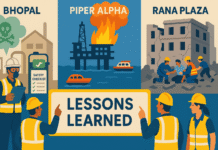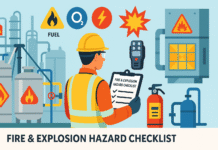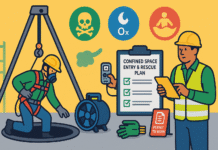
Concrete Pouring Risk Assessment
Concrete pouring might seem routine, but it’s loaded with serious risks — chemical exposure, heavy lifting, working near moving pumps, and potential formwork failure. Whether you’re pouring a small slab or casting a multi-level beam, hazards are everywhere.
A concrete pouring risk assessment is a structured safety check before the pour begins. It helps identify possible hazards, evaluate who might be at risk, and control those risks to protect workers, equipment, and the structure itself.
Legal Guidelines and Safety Regulations
OSHA Concrete and Masonry Standards
OSHA’s 29 CFR 1926 Subpart Q lays out safety requirements for concrete and masonry construction, including formwork stability, PPE, and equipment operation.
UK HSE Guidance on Concrete Work
The HSE Construction Guidelines recommend safety plans, concrete pour sequencing, and formwork inspections to prevent accidents.
Indian IS Standards for Concrete Operations
Standards like IS 456:2000 and IS 2751 guide best practices for concrete work, including formwork, curing, and site safety protocols.
Common Concrete Pouring Activities
Slab Pouring
Typically involves large volume pours over rebar mesh. Risks include uneven surfaces, overpour, and vibrator mishandling.
Column and Beam Casting
Requires formwork, scaffolding, and high-level pouring. Hazards increase due to working at height and narrow working space.
Precast Panel Installation
Panels are heavy and require cranes or lifting tools. Improper rigging can lead to dangerous swings or drops.
Pump and Bucket Pouring Methods
Pumping offers speed but comes with high pressure risks. Buckets can be unstable and prone to spillage.
Key Hazards in Concrete Pouring
Skin Contact and Chemical Burns
Wet concrete is highly alkaline and can cause severe burns. Exposure occurs from splashes, kneeling, or improper glove use.
Formwork Failure and Collapse
Overloading or improper bracing can lead to sudden collapse — risking injury and pour loss.
Manual Handling Injuries
Rebar tying, lifting hoses, or adjusting formwork can strain backs, shoulders, and wrists.
Slips, Trips, and Falls
Wet surfaces, rebar sticking out, or cluttered work zones make slips common during and after the pour.
Pump Hose Whip Hazards
High-pressure hoses can whip dangerously if pressure is released suddenly — especially when blocked.
Equipment Movement and Site Traffic
Mixers, cranes, and pump trucks increase the risk of vehicle-related injuries during pouring.
Steps in a Concrete Pouring Risk Assessment
Step 1 – Identify All Hazards
Look at the task from start to finish — from concrete delivery to formwork removal.
Step 2 – Identify Who May Be Harmed
Workers handling hoses, standing on formwork, machine operators, and nearby trades.
Step 3 – Assess the Risk and Plan Controls
Evaluate the likelihood and severity of each hazard. Assign specific control actions.
Step 4 – Document and Share the Assessment
Print the assessment. Discuss it in pre-pour meetings and keep a copy on-site.
Step 5 – Monitor and Update Continuously
Any change in method, weather, or crew means the assessment should be reviewed and updated.
Control Measures for Concrete Pouring
Use of Proper PPE
Rubber gloves, waterproof boots, full-sleeve clothing, safety goggles, and dust masks must be mandatory.
Formwork Inspection and Support
Check for tight joints, adequate bracing, and clean surfaces. No pour should happen without a safety check.
Equipment Pre-Checks and Operator Training
Pump pressure, hose clamps, and crane rigging must be inspected. Only certified operators should handle machinery.
Safe Pouring Sequences and Communication
Always pour from the farthest point to avoid walking through wet concrete. Use hand signals or radios for coordination.
Emergency Spill and Rescue Procedures
Have absorbent materials, washing stations, and first-aid for chemical burns nearby.
Hierarchy of Controls in Concrete Work
Eliminate – Use Ready-Mix or Precast Where Possible
Precast slabs or columns reduce onsite risks significantly.
Substitute – Use Pumping Instead of Manual Carrying
Avoid bucket pouring where mechanical pumping is safer and more controlled.
Engineering Controls – Barriers, Shutters, Safety Lines
Install edge protection, guardrails, and warning tapes around wet pour zones.
Administrative Controls – Permits, Toolbox Talks
Require work permits for elevated pours. Conduct safety talks before every large pour.
PPE – Gloves, Boots, Eye and Respiratory Protection
As always, PPE is the last line of defense and must complement higher-level controls.
Best Practices for Concrete Pouring Safety
Monitor Weather Conditions
Rain or high heat can affect pour quality and safety. Avoid pours during extreme conditions.
Use Vibrators Safely to Avoid Crush Injuries
Vibrators can get caught in rebar or concrete. Operate with both hands and never place them between formwork gaps.
Avoid Overloading Formwork
Respect the load rating. Pour in layers or intervals to prevent hydrostatic pressure buildup.
Real-Life Case Studies
Case 1: Concrete Burn Due to Lack of PPE
A laborer working barefoot developed severe burns requiring hospitalization. Lesson: Always wear boots and gloves.
Case 2: Formwork Collapse During Slab Pour
Due to poor shoring, the slab collapsed midway through the pour, injuring four. Lesson: Formwork inspection must never be skipped.
Concrete Pouring Risk Assessment Template
What to Include
- Task description
- Location and type of pour
- Identified hazards
- Risk ratings (before and after controls)
- Assigned controls and responsible person
- Emergency procedures
- Review date and approval
Daily Usage in the Field
Update the template each morning. Review with all crew before starting. Display on the notice board and keep a signed copy with the supervisor.
Risk Assessment – Concrete Pouring Activity
General Information
- Project/Site Name: ABC Infrastructure – Residential Tower Project
- Assessment Title: Risk Assessment for Concrete Pouring
- Location: Podium Slab – Level 2
- Assessed By: Mahendra Lanjewar (Safety Officer)
- Assessment Date: 01 July 2025
- Review Date: 01 October 2025
- Activity Description: Pouring ready-mix concrete using concrete pump and manual labor for slab, beam, and column casting.
Concrete Pouring Risk Assessment Table
| Task | Hazards Identified | Persons at Risk | Risk Rating (Before Control) | Control Measures | Risk Rating (After Control) | Responsible Person |
|---|---|---|---|---|---|---|
| 1. Site preparation for pouring | Slips, trips due to uneven surface, rebar projections | Concrete workers, supervisors | High | – Level work surface before pouring – Cap exposed rebars – Maintain proper access and lighting | Low | Site Supervisor |
| 2. Operation of concrete pump | Mechanical failure, hose whipping, entrapment | Pump operator, pour team | High | – Only trained and certified pump operators – Secure pump hose – Keep hands away from pipe joints – Conduct pre-use inspection | Low | Equipment Operator |
| 3. Pouring concrete into formwork | Collapse of formwork, overloading | All workers near formwork | High | – Use approved shuttering and staging – Do not overload forms – Supervise pour rate – Engineer to approve formwork before pouring | Low | Site Engineer / Foreman |
| 4. Manual handling of concrete (wheelbarrows, buckets) | Back strain, fatigue, slips | Laborers | Medium | – Use mechanical means when possible – Team handling for heavy loads – Provide adequate rest breaks | Low | Supervisor |
| 5. Direct contact with wet concrete | Skin irritation, chemical burns | Pouring crew | Medium | – Use waterproof gloves, boots, and long sleeves – Provide wash stations – Training on cement hazards | Low | Safety Officer |
| 6. Working at height while pouring slabs | Fall from slab edges or platforms | Pouring crew | High | – Install guardrails and toe boards – Use fall arrest harness where needed – No work without permit at height | Low | Safety Officer |
| 7. Concrete spillage | Slips, blocked access routes | Site workers | Medium | – Use trays or covers to contain spills – Clean immediately – Allocate clear walkways | Low | Labor Foreman |
| 8. Vibrating concrete using poker vibrator | Hand-arm vibration, electric shock | Vibrator operator | Medium | – Use insulated equipment – Wear anti-vibration gloves – Limit duration of exposure | Low | Operator / Safety Officer |
| 9. Post-pour surface leveling | Repetitive strain, manual fatigue | Finishing team | Medium | – Use long-handled floats – Rotate tasks – Provide ergonomic tools | Low | Finishing Supervisor |
Risk Rating Matrix
| Severity | Likelihood | Risk Rating |
|---|---|---|
| 1 – Minor injury | 1 – Unlikely | Low |
| 2 – Moderate injury | 2 – Possible | Medium |
| 3 – Serious/fatal injury | 3 – Likely | High |
Formula: Risk Rating = Severity × Likelihood
Additional Notes
- PPE Required: Safety helmet, gloves, rubber boots, goggles, high-visibility vest, long-sleeve shirts, and respiratory mask (if silica dust is present).
- Permit to Work: Required for slab work at height and night pouring.
- Pre-Pour Inspection: Must be done by Engineer and Safety Officer before pouring begins.
- Communication: Use walkie-talkies or hand signals between pump operator and pour crew.
- Lighting: Ensure adequate lighting for early morning or night pours.
Emergency Measures
- First Aid: Fully stocked first aid box nearby with trained first aider present.
- Concrete Burn Management: Emergency eyewash and clean water supply must be nearby.
- Rescue Plan: In place for height-related work.
Training Requirements
- Workers must be trained in:
- Safe use of concrete pumps and vibrators
- PPE and cement hazard awareness
- Manual handling techniques
- Working at height safety
- Emergency procedures for collapse or accidents
Review and Sign-Off
| Name | Designation | Signature | Date |
|---|---|---|---|
| Rupesh Wasnik | Safety Officer | [Signature] | 01-07-2025 |
| Rakesh Kumar | Project Manager | [Signature] | 01-07-2025 |
| Manoj Yadav | Site Engineer | [Signature] | 01-07-2025 |
Conclusion
Concrete work isn’t just another task — it’s a time-sensitive, high-risk operation that demands attention to detail and a solid safety plan. From burns to collapses, risks are real and preventable. That’s where a thorough concrete pouring risk assessment plays its role — anticipating dangers before they become disasters.
Plan the pour. Protect the team. Perfect the process. Because when it comes to concrete, there’s no room for error.
Reinforcement Steel Fixing Risk Assessment
Material Lifting Risk Assessment
Confined Space Risk Assessment
FAQs
1. Can concrete burn the skin?
Yes. Wet concrete is highly alkaline and can cause deep chemical burns within hours of exposure.
2. What is the safest method of pouring concrete?
Pumping is generally safer than manual handling or crane buckets, especially on larger sites.
3. How do you control dust while mixing or pouring?
Use pre-mixed concrete, add water slowly, and wet surfaces to control airborne dust.
4. Is PPE enough for concrete work safety?
No. PPE is important but must be used with proper planning, equipment checks, and risk assessments.
5. When should formwork be inspected?
Before every pour, after any heavy rain or site disturbance, and always after modifications.
























